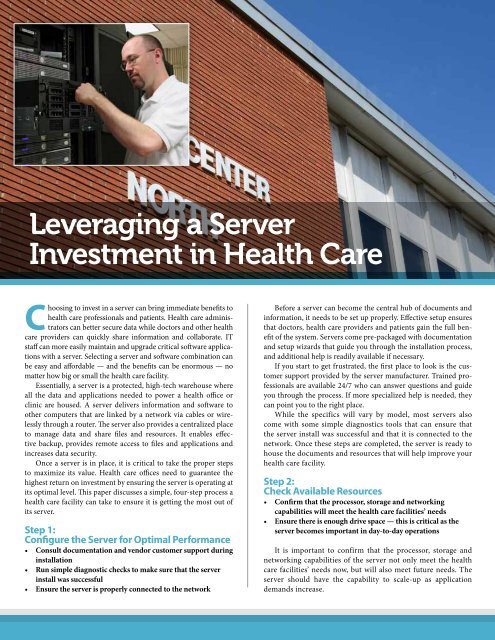Leveraging a Server Investment in Health Care - Navigator
Leveraging a Server Investment in Health Care - Navigator
Leveraging a Server Investment in Health Care - Navigator
You also want an ePaper? Increase the reach of your titles
YUMPU automatically turns print PDFs into web optimized ePapers that Google loves.
<strong>Leverag<strong>in</strong>g</strong> a <strong>Server</strong><br />
<strong>Investment</strong> <strong>in</strong> <strong>Health</strong> <strong>Care</strong><br />
Choos<strong>in</strong>g to <strong>in</strong>vest <strong>in</strong> a server can br<strong>in</strong>g immediate benefits to<br />
health care professionals and patients. <strong>Health</strong> care adm<strong>in</strong>istrators<br />
can better secure data while doctors and other health<br />
care providers can quickly share <strong>in</strong>formation and collaborate. IT<br />
staff can more easily ma<strong>in</strong>ta<strong>in</strong> and upgrade critical software applications<br />
with a server. Select<strong>in</strong>g a server and software comb<strong>in</strong>ation can<br />
be easy and affordable — and the benefits can be enormous — no<br />
matter how big or small the health care facility.<br />
Essentially, a server is a protected, high-tech warehouse where<br />
all the data and applications needed to power a health office or<br />
cl<strong>in</strong>ic are housed. A server delivers <strong>in</strong>formation and software to<br />
other computers that are l<strong>in</strong>ked by a network via cables or wirelessly<br />
through a router. The server also provides a centralized place<br />
to manage data and share files and resources. It enables effective<br />
backup, provides remote access to files and applications and<br />
<strong>in</strong>creases data security.<br />
Once a server is <strong>in</strong> place, it is critical to take the proper steps<br />
to maximize its value. <strong>Health</strong> care offices need to guarantee the<br />
highest return on <strong>in</strong>vestment by ensur<strong>in</strong>g the server is operat<strong>in</strong>g at<br />
its optimal level. This paper discusses a simple, four-step process a<br />
health care facility can take to ensure it is gett<strong>in</strong>g the most out of<br />
its server.<br />
Step 1:<br />
Configure the <strong>Server</strong> for Optimal Performance<br />
• Consult documentation and vendor customer support dur<strong>in</strong>g<br />
<strong>in</strong>stallation<br />
• Run simple diagnostic checks to make sure that the server<br />
<strong>in</strong>stall was successful<br />
• Ensure the server is properly connected to the network<br />
Before a server can become the central hub of documents and<br />
<strong>in</strong>formation, it needs to be set up properly. Effective setup ensures<br />
that doctors, health care providers and patients ga<strong>in</strong> the full benefit<br />
of the system. <strong>Server</strong>s come pre-packaged with documentation<br />
and setup wizards that guide you through the <strong>in</strong>stallation process,<br />
and additional help is readily available if necessary.<br />
If you start to get frustrated, the first place to look is the customer<br />
support provided by the server manufacturer. Tra<strong>in</strong>ed professionals<br />
are available 24/7 who can answer questions and guide<br />
you through the process. If more specialized help is needed, they<br />
can po<strong>in</strong>t you to the right place.<br />
While the specifics will vary by model, most servers also<br />
come with some simple diagnostics tools that can ensure that<br />
the server <strong>in</strong>stall was successful and that it is connected to the<br />
network. Once these steps are completed, the server is ready to<br />
house the documents and resources that will help improve your<br />
health care facility.<br />
Step 2:<br />
Check Available Resources<br />
• Confirm that the processor, storage and network<strong>in</strong>g<br />
capabilities will meet the health care facilities’ needs<br />
• Ensure there is enough drive space — this is critical as the<br />
server becomes important <strong>in</strong> day-to-day operations<br />
It is important to confirm that the processor, storage and<br />
network<strong>in</strong>g capabilities of the server not only meet the health<br />
care facilities’ needs now, but will also meet future needs. The<br />
server should have the capability to scale-up as application<br />
demands <strong>in</strong>crease.
While servers are typically shipped with ample drive space,<br />
there is always room for more — especially as the price of storage<br />
cont<strong>in</strong>ues to drop. Consider<strong>in</strong>g external drives can be beneficial,<br />
both for amplify<strong>in</strong>g the utility of a server and extend<strong>in</strong>g its life.<br />
With eSATA (External Serial Advanced Technology Attachment),<br />
an external hard drive can be accessed just as quickly as one <strong>in</strong>side<br />
the server itself. Alternatively, health care facilities can choose to<br />
have an external drive kept offsite or use a cloud-comput<strong>in</strong>g service<br />
to back up data and prevent data loss. Offsite storage capabilities<br />
cont<strong>in</strong>ue to improve, so keep an eye out for the backup options<br />
available <strong>in</strong> the cloud.<br />
Step 3:<br />
Load Your Applications<br />
• Inventory the applications you plan to use<br />
• Install applications accord<strong>in</strong>g to manufacturer <strong>in</strong>structions<br />
• Look for additional applications that can <strong>in</strong>crease the value of<br />
the <strong>in</strong>vestment<br />
It is important to keep track of what applications need to be<br />
<strong>in</strong>stalled for your health care facility and that they are correctly<br />
loaded. Help is available to guide you through these steps and you<br />
will want to follow all the manufacturer <strong>in</strong>structions to ensure optimum<br />
performance of the server. Usually, questions about an application<br />
need to be directed to the software maker who provided that<br />
particular program. They have the <strong>in</strong>-depth expertise needed to<br />
troubleshoot their software.<br />
<strong>Health</strong> care offices need to<br />
guarantee the highest return on<br />
<strong>in</strong>vestment by ensur<strong>in</strong>g the server is<br />
operat<strong>in</strong>g at its optimal level.<br />
Other applications may be available that <strong>in</strong>crease the value of<br />
server <strong>in</strong>vestments and ease the management of a server-based<br />
network. For <strong>in</strong>stance, a management console application is<br />
designed to make network management easier by giv<strong>in</strong>g health<br />
care adm<strong>in</strong>istrators and IT staff a bird’s-eye view of the network.<br />
It shows the status of anti-spam and anti-virus applications with a<br />
simple color-coord<strong>in</strong>ated threat level system, and sends alerts for<br />
necessary software updates. With a console, you can view critical<br />
<strong>in</strong>formation about your computers and network. The server can<br />
also e-mail customized reports when time is limited. That way, a<br />
snapshot of the network’s health can be delivered to your <strong>in</strong>box<br />
every morn<strong>in</strong>g.<br />
Step 4:<br />
Ensure Security and Backup Protections<br />
• Configure backup services to avoid unexpected data loss<br />
• Guard the system aga<strong>in</strong>st power failures<br />
• Set up security precautions to protect patient data<br />
The loss of data due to system failure or disaster sets back<br />
doctors and health care providers, render<strong>in</strong>g them unable to<br />
focus on the needs of patients. Data loss due to system failure is<br />
easily preventable and health care facilities can reduce the damage<br />
<strong>in</strong> the event of a disaster (fire, flood, earthquake, etc.). The<br />
chance of disaster or server failure can be greatly m<strong>in</strong>imized by<br />
us<strong>in</strong>g care and plac<strong>in</strong>g a server <strong>in</strong> a dry, cool and secure environment.<br />
In any event, always make sure to schedule regular system<br />
backups and test the backup system before it is actually needed.<br />
Keep <strong>in</strong> m<strong>in</strong>d that health care providers must comply with<br />
federal and state privacy regulation — namely HIPAA. Viruses,<br />
malware and other security breaches halt patient services and<br />
negatively impact trust <strong>in</strong> a health care facility. Cyber crim<strong>in</strong>als<br />
that plague bus<strong>in</strong>esses have set their sights on cl<strong>in</strong>ics and hospitals.<br />
Recently, a medical center <strong>in</strong> Richland, Wash., had a server<br />
hacked. The data breach exposed patient names, dates of birth,<br />
ages, genders, medical record numbers and doctors’ names and,<br />
as a result, the server was removed from service and a firm was<br />
hired to <strong>in</strong>vestigate the data breach.<br />
Conclusion<br />
To recap, there are four steps health care adm<strong>in</strong>istrators can<br />
take to ensure the peak performance of a server. Beg<strong>in</strong> by configur<strong>in</strong>g<br />
the server — configuration can be double-checked by runn<strong>in</strong>g<br />
a diagnostic after <strong>in</strong>stallation. Next, check available resources<br />
— external hard drives and the cloud allow servers to hold more<br />
space and enable virtualization capabilities. Then, load applications<br />
as the server will act as a hub for doctors, health care providers<br />
and patients, allow<strong>in</strong>g them to share <strong>in</strong>formation and data <strong>in</strong><br />
accordance with HIPAA. Also, look for applications that can make<br />
ma<strong>in</strong>tenance of the server more user-friendly for IT staff. F<strong>in</strong>ally,<br />
make sure that data is secure and backed up — schedule regular<br />
backups and place the server <strong>in</strong> a secure location to avoid physical<br />
damage to the server.<br />
For more <strong>in</strong>formation please contact a Dell representative at 1-877-818-0419 or visit www.dell.com/healthcareserver.<br />
The first step <strong>in</strong> build<strong>in</strong>g your Dell network<br />
solution is to meet the needs of your healthcare<br />
organization and speed up productivity by<br />
f<strong>in</strong>d<strong>in</strong>g the right Dell server.<br />
Work with your dedicated healthcare team<br />
to build a network solution to help you keep<br />
patient data secure and accessible.<br />
Choose the Microsoft server operat<strong>in</strong>g system that’s the<br />
best fit for your healthcare practice<br />
Entry-level server operat<strong>in</strong>g system for runn<strong>in</strong>g bus<strong>in</strong>ess<br />
applications and shar<strong>in</strong>g <strong>in</strong>formation and resources. Up to 15 users<br />
Advanced server operat<strong>in</strong>g system with built-<strong>in</strong> virtualization capabilities<br />
for <strong>in</strong>creased reliability and security. Unlimited users<br />
All-<strong>in</strong>-one server suite for enhanced designed for small bus<strong>in</strong>esses<br />
productivity and a more professional bus<strong>in</strong>ess image. Up to 75 users<br />
© 2011 e.Republic. All rights reserved. 100 Blue Rav<strong>in</strong>e Road, Folsom, CA 95630 | 916-932-1300 phone | 916-932-1470 fax | www.centerdigitalgov.com







